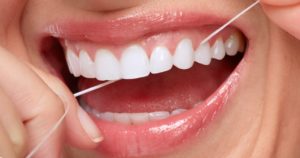 On top of brushing, you need to floss every day in order to keep your teeth and gums healthy. This has been drilled into your head since you were very young, but many people still don’t have this step as a regular part of their routine. On top of that, there are all sorts of common mistakes that you could be making even if you are a diligent flosser. Continue reading to learn about some common flossing mistakes so you know to avoid them in the future.
On top of brushing, you need to floss every day in order to keep your teeth and gums healthy. This has been drilled into your head since you were very young, but many people still don’t have this step as a regular part of their routine. On top of that, there are all sorts of common mistakes that you could be making even if you are a diligent flosser. Continue reading to learn about some common flossing mistakes so you know to avoid them in the future.
Not Enough Floss
If you aren’t using enough dental floss, it is difficult to thoroughly clean your teeth. The American Dental Association (ADA) recommends that you use about 18 inches of dental floss every time you brush your teeth. You should be able to wrap the string around your fingers and have a clean area to use between each tooth.
Staying Above the Gumline
While flossing, you need to be pulling the string down about two to three millimeters below the gumline so that you are thoroughly removing plaque and bacteria from your gums. This way, you can protect yourself against periodontal disease. Glide up and down the surface of the tooth and beneath the gumline to loosen up food particles, plaque, and bacteria.
Wrong Time
It’s great that you’re flossing, but do you know when the best time to floss is? Since your saliva flow decreases when you are sleeping, food particles that are left behind are even more likely to begin the bacterial breakdown process. Because of this, you are more likely to experience inflammation and decay. Ultimately, flossing before bed each night is crucial for your oral health.
Out of Order
You aren’t necessarily wrong if you floss after you brush, but flossing first is probably your best bet. According to a study in the Journal of Periodontology, the participants who flossed before brushing tended to have less plaque left behind the teeth. Also, the fluoride in your toothpaste is more likely to coat areas between the teeth if you have already flossed.
Too Aggressive
If you are snapping the string into your floss of being too aggressive, you could cause trauma to the soft tissues in your mouth. Slide the floss gently and do not saw at the base of the gum. You don’t want to cause gum recession later on.
Stopping at the Sight of Blood
If there is blood when you are flossing, this is generally a sign that you should be flossing more often than you are. Over time, this will eventually go away. This is one of the crucial steps for keeping your gum tissue healthy.
Partial Flossing
Instead of just going down and up with your floss, you need to be wrapping your tooth with the string so that you clean the entire area and not just the area between the teeth. Make a c-shape around your tooth and slide the string up and down.
Flossing is crucial for your oral health! That’s why it’s so important that you are doing it correctly. Next time you floss, make sure that you aren’t making any of the common mistakes above. This way, you will be able to prevent dental problems and maintain excellent oral health!
About the Author
Dr. Karl Arakelian is an experienced dentist who has spent nearly 30 years working in the dental field. He earned his Doctor of Dental Medicine from the University of Pennsylvania in Philadelphia and has attended over a thousand hours of continuing education since then. He is currently a member of the Massachusetts Dental Association. For more information on proper oral hygiene or to schedule an appointment, visit his website or call (978) 373-0901.






